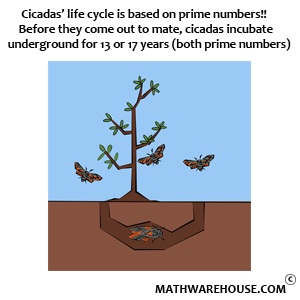Quick Overview
- $$\displaystyle \frac d {dx}\left(\ln x\right) = \frac 1 x$$
- $$\displaystyle \frac d {dx}\left(\log_b x\right) = \frac 1 {(\ln b)\,x}$$
- Basic Idea: the derivative of a logarithmic function is the reciprocal of the stuff inside.
- Using the properties of logarithms will sometimes make the differentiation process easier.
Basic Idea
The derivative of a logarithmic function is the reciprocal of the argument. As always, the chain rule tells us to also multiply by the derivative of the argument. So if $$f(x) = \ln(u)$$ then
$$f'(x) = \frac 1 u \cdot u'$$
Examples
Example 1
Suppose $$f(x) = \ln(8x-3)$$. Find $$f'(x)$$
Step 1Differentiate by taking the reciprocal of the argument. Don't forget the chain rule!
$$ f'(x) = \frac 1 {8x-3}\cdot \underbrace{\frac d {dx} (8x-3)}_{\mbox{Chain rule}} = \frac 1 {8x-3} \cdot 8 = \frac 8 {8x-3} $$
Answer$$\displaystyle f'(x) = \frac 8 {8x-3}$$
Example 2
Find and simplify $$\displaystyle \frac d {dx}\left(\ln \sin x\right)$$.
Step 1Differentiate by taking the reciprocal of the argument. Don't forget the chain rule!
$$ f'(x) = \frac 1 {\sin x} \cdot \underbrace{\frac d {dx}(\sin x)}_{\mbox{Chain rule}} = \frac 1 {\sin x}\cdot \cos x $$
Step 2Simplify.
$$ f'(x) = \frac 1 {\sin x}\cdot \cos x = \frac{\cos x}{\sin x} = \cot x $$
Answer$$\displaystyle \frac d {dx}\left(\ln \sin x\right) = \cot x$$.
Example 3
Suppose $$f(x) = \log_6(x^3 + 9x)$$. Find $$f'(2)$$.
Step 1Differentiate using the formula for derivatives of logarithmic functions. Don't forget the chain rule!
$$ \begin{align*} f'(x) & = \frac 1 {(\ln 6)(x^3 + 9x)}\cdot \frac d {dx}(x^3+9x)\\[6pt] & = \frac 1 {(\ln 6)(x^3 + 9x)}\cdot (3x^2+9)\\[6pt] & = \frac{3x^2+9}{(\ln 6)(x^3 + 9x)} \end{align*} $$
Step 2Evaluate $$f'(2)$$
$$ \begin{align*} f'(\blue 2) & = \frac{3\blue{(2)}^2+9}{(\ln 6)(\blue{(2)}^3 + 9\blue{(2)})}\\[6pt] & = \frac{3(4)+9}{(\ln 6)(8 + 18)}\\[6pt] & = \frac{21}{(\ln 6)(26)}\\[6pt] & = \frac{21}{26\ln 6} \end{align*} $$
Answer$$ \displaystyle f'(2) = \frac{21}{26\ln 6} $$
Using the Properties of Logarithims
When the argument of the logarithmic function involves products or quotients we can use the properties of logarithms to make differentiating easier.
For example, consider $$f(x) = \ln(x^2\sin x)$$. It's derivative is
$$ f'(x) = \frac 1 {x^2\sin x} \cdot \underbrace{\frac d {dx}(x^2\sin x).}_\mbox{Requires the} \\ \hspace{28mm} \mbox{Product Rule} $$
We can avoid the product rule by first re-writing the function using the properties of logarithms and then differentiating, as shown below.
$$ f(x) = \ln(x^2\sin x) = 2\ln x + \ln \sin x $$
So the derivative is
$$ f'(x) = 2 \cdot \frac 1 x + \frac 1 {\sin x}\cdot \cos x = \frac 2 x + \cot x $$
Example 4
Suppose $$\displaystyle f(x) = \ln\left(\frac{\sqrt x}{x^2 + 4}\right)$$. Find $$f'(x)$$ by first expanding the function and then differentiating.
Step 1Use the properties of logarithms to expand the function.
$$ \begin{align*} f(x) & = \ln\left(\frac{\sqrt x}{x^2 + 4}\right)\\[6pt] & = \ln\left(\frac{x^{1/2}}{x^2 + 4}\right)\\[6pt] & = \frac 1 2 \ln x - \ln(x^2 + 4) \end{align*} $$
Step 2Differentiate the logarithmic functions. Don't forget the chain rule!
$$ \begin{align*} f'(x) & = \frac 1 2 \cdot \frac 1 x - \frac 1 {x^2 + 4} \cdot \frac d {dx} (x^2 + 4)\\[6pt] & = \frac 1 {2x} - \frac 1 {x^2 + 4} \cdot 2x\\[6pt] & = \frac 1 {2x} - \frac{2x}{x^2 + 4} \end{align*} $$
Answer$$ \displaystyle f'(x) = \frac 1 {2x} - \frac{2x}{x^2 + 4} $$
Practice Problems
Differentiate using the formula for derivatives of logarithms. Don't forget the chain rule!
$$ \begin{align*} f'(x) & = \frac 1 {4x+5} \cdot \frac d {dx}(4x+5)\\[6pt] & = \frac 1 {4x+5}\cdot 4\\[6pt] & = \frac 4 {4x+5} \end{align*} $$
$$\displaystyle f'(x) = \frac 4 {4x+5}$$
Differentiate using the formula for derivatives of logarithms. Don't forget the chain rule!
$$ \begin{align*} f'(x) & = \frac 1 {2 - \frac 4 3 x}\cdot \frac d {dx}\left(2 - \frac 4 3 x\right)\\[6pt] & = \frac 1 {2 - \frac 4 3 x}\cdot \left(- \frac 4 3\right)\\[6pt] \end{align*} $$
Simplify the derivative.
$$ \begin{align*} f'(x) & = \frac 1 {2 - \frac 4 3 x}\cdot \left(- \frac 4 3\right)\\[6pt] & = \frac 4 {\left(2 - \frac 4 3 x\right)(-3)}\\[6pt] & = \frac 4 {-6 + 4x}\\[6pt] & = \frac 4 {4x-6} \end{align*} $$
Evaluate $$f'(12)$$.
$$ f'(\blue{12}) = \frac 4 {4\blue{(12)} -6} = \frac 4 {42} = \frac 2 {21} $$
$$f'(12) = \frac 2 {21}$$
Differentiate using the derivatives of logarithms formula. Don't forget the chain rule!
$$ \begin{align*} f'(x) & = \frac 1 {\tan x}\cdot \frac d {dx}(\tan x)\\[6pt] & = \frac 1 {\tan x}\cdot (\sec^2 x)\\[6pt] & = \cot x \sec^2 x \end{align*} $$
Simplify.
$$ \begin{align*} f'(x) & = \cot x\sec^2 x\\[6pt] & = \frac{\cos x}{\sin x}\cdot \frac 1 {\cos^2 x}\\[6pt] & = \frac 1 {\sin x}\cdot\frac 1 {\cos x}\\[6pt] & = \csc x\sec x \end{align*} $$
$$ \displaystyle f'(x) = \csc x\sec x $$
Differentiate using the formula for derivatives of logarithms. Don't forget the chain rule!
$$ \begin{align*} f'(x) & = \frac 1 {\operatorname{csch} x}\cdot \frac d {dx} (\operatorname{csch} x)\\[6pt] & = \frac 1 {\operatorname{csch} x}\cdot (-\operatorname{csch} x\coth x)\\[6pt] & = - \coth x \end{align*} $$
$$f'(x) = - \coth x$$
Rewrite the function so the square-root is in exponent form.
$$ f(x) = (3x-1)^{1/2}\,\ln(7x+2) $$
Identify the factors used in the function.
$$ f'(x) = \blue{(3x-1)^{1/2}}\,\red{\ln(7x+2)} $$
Differentiate using the product rule.
$$ \begin{align*} f'(x) & = \blue{\frac 1 2 (3x-1)^{-1/2}\cdot 3}\cdot\ln(7x+2) + (3x-1)^{1/2}\cdot\red{\frac 1 {7x+2}\cdot 7}\\[6pt] & = \frac 3 2 (3x-1)^{-1/2}\cdot\ln(7x+2) + (3x-1)^{1/2}\cdot\frac 7 {7x+2}\\[6pt] \end{align*} $$
Simplify.
$$ \begin{align*} f'(x) & = \frac 3 2 (3x-1)^{-1/2}\cdot\ln(7x+2) + (3x-1)^{1/2}\cdot\frac 7 {7x+2}\\[6pt] & = \frac 3 2\cdot \frac 1 {(3x-1)^{1/2}}\cdot\ln(7x+2) + \frac{7(3x-1)^{1/2}}{7x+2}\\[6pt] & = \frac{3\ln(7x+2)}{2\sqrt{3x-1}} + \frac{7\sqrt{3x-1}}{7x+2} \end{align*} $$
$$ \displaystyle f'(x) = \frac{3\ln(7x+2)}{2\sqrt{3x-1}} + \frac{7\sqrt{3x-1}}{7x+2} $$
Differentiate using the quotient rule. The parts in $$\blue{blue}$$ are related to the numerator.
$$ \begin{align*} f'(x) & = \frac{(8x-1)\cdot \blue{\frac 1 {5x+3}\cdot 5} - \blue{\ln(5x+3)}\cdot 8}{(8x-1)^2}\\[6pt] & = \frac{(8x-1)\cdot \frac 5 {5x+3} - 8\ln(5x+3)}{(8x-1)^2} \end{align*} $$
Simplify.
$$ \begin{align*} f'(x) & = \frac{(8x-1)\cdot \frac 5 {5x+3} - 8\ln(5x+3)}{(8x-1)^2}\cdot \blue{\frac{5x+3}{5x+3}}\\[6pt] & = \frac{5(8x-1) - 8(5x+3)\ln(5x+3)}{(5x+3)(8x-1)^2} \end{align*} $$
$$ \displaystyle f'(x) = \frac{5(8x-1) - 8(5x+3)\ln(5x+3)}{(5x+3)(8x-1)^2} $$
Expand the function using the properties of logarithms.
$$ \begin{align*} f(x) & = \ln(9x^{1/3}\sec x)\\[6pt] & = \ln 9 + \ln x^{1/3} + \ln \sec x\\[6pt] & = \ln 9 + \frac 1 3 \ln x + \ln \sec x \end{align*} $$
Differentiate each term.
$$ \begin{align*} f'(x) & = 0 + \frac 1 3\cdot \frac 1 x + \frac 1 {\sec x}\cdot \frac d {dx} (\sec x)\\[6pt] & = \frac 1 {3x} + \cos x \cdot \sec x\tan x\\[6pt] & = \frac 1 {3x} + \tan x \end{align*} $$
$$\displaystyle f'(x) = \frac 1 {3x} + \tan x$$
Expand the function using the properties of logarithms.
$$ \begin{align*} f(x) & = \ln(2^{-0.4x}) + \ln(\cos 6x)\\[6pt] & = -0.4x\ln 2 + \ln(\cos 6x)\\[6pt] & = -(0.4\ln 2)x + \ln(\cos 6x) \end{align*} $$
Differentiate each term.
$$ \begin{align*} f'(x) & = -0.4\ln 2 + \frac 1 {\cos 6x}\cdot \frac d {dx}(\cos 6x)\\[6pt] & = -0.4\ln 2 + \frac 1 {\cos 6x}\cdot (-6\sin 6x)\\[6pt] & = -0.4\ln 2 -6\cdot \frac{\sin 6x}{\cos 6x}\\[6pt] & = -0.4\ln 2 - 6\tan 6x \end{align*} $$
$$\displaystyle f'(x) = -0.4\ln 2 - 6\tan 6x$$


















